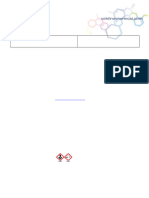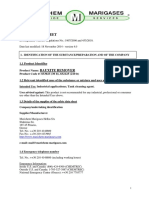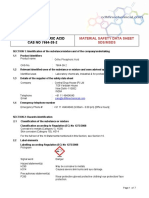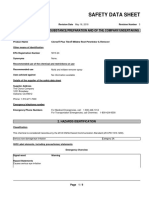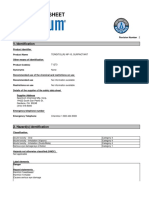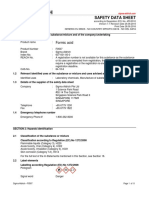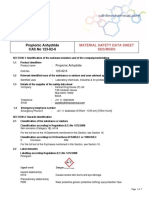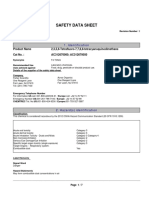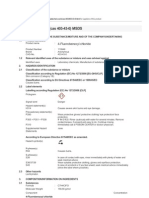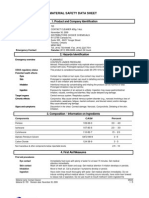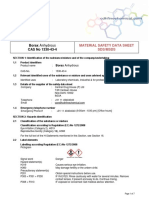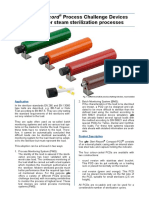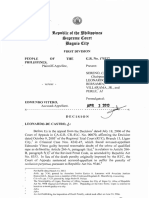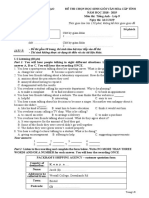Cleanser
Cleanser
Uploaded by
recepersinCopyright:
Available Formats
Cleanser
Cleanser
Uploaded by
recepersinCopyright
Available Formats
Share this document
Did you find this document useful?
Is this content inappropriate?
Copyright:
Available Formats
Cleanser
Cleanser
Uploaded by
recepersinCopyright:
Available Formats
Page 1 of 10
SAFETY DATA SHEET
Doc. ID: 300-7664 Rev. AC
. Revised (year/month/day) 2015/03/30
Section 1 Identication of the Substance/mixture and of the Company/undertaking
1.1
1.2
1.3
Product Identier
Product Name
Iris System Cleanser
800-3203
Part Number
iQ 200
Series Name
Relevant identied uses of the substance or mixture and uses advised against
For In Vitro Diagnostic Use. See product literature for details.
Product Use
Details of the supplier of the safety data sheet
Manufacturer
EC REP Address
IRIS International, Inc.
9172 Eton Avenue
Chatsworth, CA 91311-5874, U.S.A.
Tel: 800-776-4747
818-527-7000
contactIDD@beckman.com
1.4
mdi Europa GmbH
Langenhagener Str. 71
30855 Hannover-Langenhagen
Germany
+49-511-39089530
e-mail address
Emergency telephone number
Chemtrec Emergency Tel No. U.S.A. 800-424-9300, International (001)
Telephone number (24H)
703-527-3887
Distributor and Emergency Phone No.
(800) 776-4747
Section 2 Hazards Identication
2.1 Classication of substance or mixture
Product Description
Mixture
Pale yellow; Clear; Liquid; Bleach odor
Classication according to EC 1272/2008 (CLP/GHS)
Skin Corrosion Category 1
Eye Damage Category 1
Classication according to EC Directives 1999/45/EC and 67/548/EEC
Not classied as dangerous per EC Directives (1999/45/EC and 67/548 EEC)
2015 Iris Diagnostics
Global SDS English
Page 2 of 10
SAFETY DATA SHEET
Doc. ID: 300-7664 AC
. Revised (year/month/day) 2015/03/30
Iris System Cleanser
Section 2 Hazards Identication (Continued)
Classication according to US-OSHA (HCS 29 CFR 1910.1200) and UN GHS
Skin Corrosion Category 1
Eye Damage Category 1
Aquatic Hazard Acute, Category 2
2.2 Label Elements
According to EC 1272/2008 (CLP/GHS), US-OSHA and UN GHS
Hazardous Ingredients
Sodium Hydroxide
Sodium Hypochlorite
Pictogram
Signal Word
DANGER
Hazard Statements
H314 Causes severe skin burns and eye damage.
H401 Toxic to aquatic life
Precautionary Statements
P273 Avoid release to the environment.
P280 Wear protective gloves, protective clothing and eye/face protection.
P301+P330+P331 IF SWALLOWED: rinse mouth. Do NOT induce vomiting.
P303+P361+P353 IF ON SKIN (or hair): Rinse skin with water.
P304+P340 IF INHALED: Remove person to fresh air and keep at rest in a
position comfortable for breathing.
P305+P351+P338 IF IN EYES: Rinse cautiously with water for several minutes.
Remove contact lenses, if present and easy to do. Continue rinsing.
P310 Immediately call a POISON CENTER or doctor/physician.
P363 Wash contaminated clothing before reuse.
P405 Store locked up.
P501 Dispose of contents/container in accordance with local/national regulations
Product label will display most signicant precautionary statements.
2.3 Other hazards
Results of PBT and vPvB assessment
PBT: Not applicable.
vPvB: Not applicable.
See Section 11 Toxicological Information for more detailed health information.
Section 3 Composition and Information on Ingredients
3.2 Mixtures
Hazardous Ingredients:
Chemical Name
Hazard Classication of Pure Ingredients
% by wt.
EU-67/548/EEC
2015 Iris Diagnostics
Global SDS English
EU 1272/2008
CLP/GHS
GHS
Page 3 of 10
SAFETY DATA SHEET
Doc. ID: 300-7664 AC
. Revised (year/month/day) 2015/03/30
Iris System Cleanser
Section 3 Composition and Information on Ingredients (Continued)
Sodium Hypochlorite
1 - 5
C;R31-34
N;R50
Aquatic Acute 1
Eye Dam. 1
Skin Corr. 1B
H314; H318; H400
Aquatic Acute 1
Eye Dam. 1
Skin Corr. 1B
H314; H318; H400
0.1 - 1
C;R 35
Eye Dam. 1
Skin Corr. 1A
H314; H318
Eye Dam. 1
Skin Corr. 1A
H314; H318
CAS # 7681-52-9
EINECS # 231-668-3
Index # 017-011-00-1
Sodium Hydroxide
CAS # 1310-73-2
EINECS # 215-185-5
Index # 011-002-00-6
See section 8 for available Occupational exposure limits
See Section 15 for additional regulatory information
See Section 16 for hazard class, hazard statements and risk phrase description
Section 4 First Aid Measures
4.1
Description of rst aid measures
If product is inhaled, move exposed individual to fresh air. If individual is not
Inhalation
breathing, begin articial respiration immediately and obtain medical attention.
4.2
Eye Contact
If product enters eyes, wash eyes gently under running water for 15 minutes or
longer, making sure that the eyelids are held open and obtain medical attention
immediately.
Skin Contact
In case of skin contact, ush with copious amounts of water for at least 15
minutes. If pain or irritation occur, obtain medical attention.
Ingestion
If ingested, wash mouth out with water. If irritation or discomfort occurs, seek
medical attention.
Most important symptoms and effects, both acute and delayed
Causes severe skin burns and eye damage.
See Section 11 Toxicological Information for more detailed health information.
4.3
Indication of any immediate medical attention and special treatment needed
No further relevant information available.
Section 5 Fire Fighting Measures
Flammable Properties
Nonammable aqueous solution.
5.1
Extinguishing Media
In case of re use carbon dioxide (CO2), dry chemical, water spray or foam.
For large res use extinguishing media suitable for surrounding re.
5.2
Special hazards arising from the substance or mixture
Special Fire and Explosion Hazards
No special hazards determined.
Hazardous Combustion Products
No combustion products posing signicant hazards are expected from this
product (an aqueous solution).
2015 Iris Diagnostics
Global SDS English
Page 4 of 10
SAFETY DATA SHEET
Doc. ID: 300-7664 AC
. Revised (year/month/day) 2015/03/30
Iris System Cleanser
Section 5 Fire Fighting Measures (Continued)
5.3
5.4
Advice for re ghters
Protective Equipment
Self-contained breathing apparatus is recommended for reghters in all
chemical re situations.
No further relevant information available.
Additional information
Section 6 Accidental Release Measures
6.1
Personal precautions, protective equipment and emergency procedures
Avoid inhaling, ingesting, and contact with eyes and skin.
Personal Precautions
Wear protective gloves, protective clothing and eye/face protection.
6.2
Environmental Precautions
6.3
Methods and material for containment and cleaning up
Absorb spilled material with an appropriate inert, non-ammable absorbent and
Spill and Leak Procedures
Contain spill to prevent migration.
Do not allow the undiluted product to enter sewers/surface or ground water.
dispose according to local regulations.
6.4
Reference to other sections
Refer sections 8 and 13.
Section 7 Handling and Storage
7.1
Precautions for safe handling Use good laboratory procedures; avoid eye and skin contact.
7.2
Conditions for safe storage, including any incompatibilities
Store at 20 to 28C, as directed on the product label.
To maintain product quality, store according to the instructions in the product
labeling.
Store away from strong acids, strong bases, strong oxidizers and incompatible
materials (section 10).
7.3
Specic end uses
No further relevant information available.
Section 8 Exposure Controls and Personal Protection
8.1
Control parameters
Exposure Limits
US OSHA
Sodium Hydroxide
2 mg/m3 TWA
CAS # 1310-73-2
ACGIH
Sodium Hydroxide
2 mg/m3 Ceiling
CAS # 1310-73-2
DFG MAK
None established
2015 Iris Diagnostics
Global SDS English
Page 5 of 10
SAFETY DATA SHEET
Doc. ID: 300-7664 AC
. Revised (year/month/day) 2015/03/30
Iris System Cleanser
Section 8 Exposure Controls and Personal Protection (Continued)
Ireland
Sodium Hydroxide
2 mg/m3 STEL
CAS # 1310-73-2
None established
IOELVs
NIOSH
Sodium Hydroxide
10 mg/m3 IDLH
CAS # 1310-73-2
8.2
Japan
None established
Exposure controls
Engineering Controls
No special engineering controls are required. Use with good general ventilation.
Eye Protection
Safety glasses or chemical goggles should be worn to prevent eye contact.
Refer U.S. OSHA 29 CFR 1910.133, European Standard EN166 or appropriate
government standards.
Skin Protection
Impervious gloves, such as Nitrile or equivalent, should be worn to prevent skin
contact.
Refer U.S. OSHA 29 CFR 1910.138, European Standard EN374 or appropriate
government standards.
Respiratory Protection
Under normal conditions, the use of this product should not require respiratory
protection. If overexposure should occur and ventilation is not adequate to
maintain airborne concentrations at acceptable levels, the use of respiratory
protection should be evaluated by a qualied professional.
Section 9 Physical and Chemical Properties
9.1
Information on basic physical and chemical properties
Physical State
Liquid
Specic Gravity
(Water=1.0)
Color
Pale yellow
Solubility
Transparency
Clear
Water
Miscible
Odor
Bleach odor
Organic
Not determined
pH
>= 12.0
Partition coefcient:
n-octanol/water
Not determined
Freezing Point
Not determined
Auto-ignition Temp.
Not applicable
Boiling Point
Not determined
Decomposition
Temperature
Not determined
Flash Point
Not applicable
Percent Volatiles
Not applicable
Evaporation Rate
Not determined
Vapor Pressure
Not determined
Flammability (Solid, Gas)
Not applicable
Viscosity
Not determined
Flammability Limits
Not applicable
Explosive Properties
Not applicable
2015 Iris Diagnostics
Global SDS English
1.01 @20C
Page 6 of 10
SAFETY DATA SHEET
Doc. ID: 300-7664 AC
. Revised (year/month/day) 2015/03/30
Iris System Cleanser
Section 9 Physical and Chemical Properties (Continued)
9.2
Vapor Density
Not determined
Odor Threshold
Not applicable
Oxidizing Properties
Not applicable
No further relevant information available.
Other Information
Section 10 Stability and Reactivity
10.1 Reactivity
No further relevant information available.
10.2 Chemical Stability
The product is stable in accordance with recommended storage conditions.
10.3 Possibility of hazardous reactions
No further relevant information available.
10.4 Conditions to Avoid
To maintain product performance keep away from strong acids, strong bases,
strong oxidizers.
Avoid exposure to heat and direct sunlight.
10.5 Incompatible materials
No further relevant information available.
10.6 Hazardous Decomposition Products
No decomposition products posing signicant hazards would be expected from
this product (an aqueous solution).
Section 11 Toxicological Information
11.1 Information on toxicological effects
Toxicity Data for Hazardous Ingredients
Sodium Hydroxide
Dermal LD50 Rabbit 1350 mg/kg
CAS # 1310-73-2
Sodium Hypochlorite
Oral LD50 Rat 8200 mg/kg; Dermal LD50 Rabbit >10000 mg/kg
CAS # 7681-52-9
Primary Routes of Exposure
Eye contact, ingestion, inhalation, and skin contact.
Skin Corrosion/Irritation
Causes severe skin burns.
Serious eye damage/eye
irritation
Causes serious eye damage.
Respiratory/skin sensitization No data available.
Carcinogenicity
No ingredients in this product are listed as carcinogens by ACGIH, IARC, NTP,
OSHA or 1272/2008 EC regulation.
Germ cell mutagenicity
No data available.
Reproductive Toxicity
No data available.
Specic target organ toxicity single exposure
No data available.
2015 Iris Diagnostics
Global SDS English
Page 7 of 10
SAFETY DATA SHEET
Doc. ID: 300-7664 AC
. Revised (year/month/day) 2015/03/30
Iris System Cleanser
Section 11 Toxicological Information (Continued)
Specic target organ toxicity repeated exposure
No data available.
Aspiration hazard
No data available.
Other Information
No further relevant information available.
Section 12 Ecological Information
12.1 Ecotoxicity
Fresh Water Species
Sodium Hydroxide
96 h LC50 Oncorhynchus mykiss: 45.4 mg/L [static]
CAS # 1310-73-2
Sodium Hypochlorite
96 h LC50 Pimephales promelas: 0.06 - 0.11 mg/L [ow-through]; 96 h
LC50 Pimephales promelas: 4.5 - 7.6 mg/L [static]; 96 h LC50 Lepomis
macrochirus: 0.4 - 0.8 mg/L [static]; 96 h LC50 Lepomis macrochirus: 0.28 1 mg/L [ow-through]; 96 h LC50 Oncorhynchus mykiss: 0.05 - 0.771 mg/L
[ow-through]; 96 h LC50 Oncorhynchus mykiss: 0.03 - <0.19 mg/L [semi-static];
96 h LC50 Oncorhynchus mykiss: 0.18 - 0.22 mg/L [static]
No information available.
CAS # 7681-52-9
Microtox
Water Flea
Sodium Hypochlorite
96 h EC50 Daphnia magna: 2.1 mg/L; 48 h EC50 Daphnia magna: 0.033 0.044 mg/L [Static]
No information available.
CAS # 7681-52-9
Fresh Water Algae
12.2 Persistence and degradability Not determined for the product.
12.3 Bioaccumulation
Not determined for the product.
12.4 Mobility in soil
Not determined for the product.
12.5 Results of PBT and vPvB assessment
Not determined for the product. PBT: Not applicable, vPvB: Not applicable.
12.6 Other Adverse Effects
Toxic to aquatic life
This product is classied as environmentally hazardous. Do not allow undiluted
product to enter sewer/surface or ground water. Dispose of contents/container to
in accordance with local/national regulations
Section 13 Disposal Considerations
13.1 Waste treatment methods
Product Waste Disposal
13.2 Additional information
Chemical residues and remains should be routinely handled as special waste. This
must be disposed of in compliance with anti-pollution and other laws of the country
concerned. To ensure compliance we recommend that you contact the relevant
(local) authorities and/or an approved waste-disposal company for information.
Suggested European waste catalogue 18 01 06* - chemicals consisting of or
containing dangerous substances. Dispose in accordance with national, state
and local waste regulations.
2015 Iris Diagnostics
Global SDS English
Page 8 of 10
SAFETY DATA SHEET
Doc. ID: 300-7664 AC
. Revised (year/month/day) 2015/03/30
Iris System Cleanser
Section 14 Transport Information
Transportation of this product is not regulated under ICAO, IMDG, US DOT, European ADR or Canadian TDG.
Section 15 Regulatory Information
15.1 Safety, health and environmental regulations/legislation specic for the substance or mixture
US Federal and State Regulations
SARA 313
No ingredients listed.
CERCLA RGs, 40 CFR 302.4
Sodium Hydroxide is listed.
Sodium Hypochlorite is listed.
California Proposition 65
No ingredients listed.
Massachusetts MSL
Sodium Hydroxide is listed.
Sodium Hypochlorite is listed.
New Jersey Dept. of Health RTK List
Sodium Hydroxide is listed.
Sodium Hypochlorite is listed.
Pennsylvania RTK
Sodium Hydroxide is listed.
Sodium Hypochlorite is listed.
EU Regulations
This SDS complies with EC Regulations 1907/2006 (REACH) and amendments.
Water Hazard Class (Germany) WGK 1, low water endangering
REACH 1907/2006 EC - Annex XIV - list of substances subject to authorization.
No ingredients listed.
According to EC Directives (1999/45/EC and 67/548 EEC)
Not classied as dangerous per EC Directives (1999/45/EC and 67/548 EEC)
Canada
This product is exempt from WHMIS label and SDS requirements.
Not applicable
PIN
Ingredients on Ingredient Disclosure List
Sodium Hydroxide
Sodium Hypochlorite
Ingredients with unknown toxicological properties
Product is exempt
15.2 Chemical Safety Assessment A Chemical Safety Assessment has not been carried out.
Some hazardous ingredients listed in Section 15 are below OSHAs and WHMIS 1.0% w/w (0.1% for carcinogens) or EUs ingredient specic
concentrations required for reporting in Section 3.
2015 Iris Diagnostics
Global SDS English
Page 9 of 10
SAFETY DATA SHEET
Doc. ID: 300-7664 AC
. Revised (year/month/day) 2015/03/30
Iris System Cleanser
Section 16 Other Information
Safety Ratings
Flammability:
Health:
Reactivity with Water:
Contact:
0
3
0
3
Code
0=None
1=Slight
2=Caution
3=Severe
Updated to GHS.
Revision Changes
Hazard Class, hazard statements and risk phrase description from section 3
Abbreviations and Acronyms
C - Corrosive
N - Dangerous for the environment
R 35 Causes severe burns.
R31 Contact with acids liberates toxic gas.
R34 Causes burns.
R50 Very toxic to aquatic organisms.
Aquatic Acute 1 - Aquatic Hazard Acute, Category 1
Eye Dam. 1 - Eye Damage Category 1
Skin Corr. 1A - Skin Corrosion Category 1A
Skin Corr. 1B - Skin Corrosion Category 1B
H314 - Causes severe skin burns and eye damage.
H318 - Causes serious eye damage.
H400 - Very toxic to aquatic life.
ACGIH - American Conference of Governmental Industrial Hygienists
ADR - European Agreement Concerning The International Carriage Of Dangerous
Goods By Road
CERCLA - The Comprehensive Environmental Response, Compensation, and
Liability Act
CLP - Classication, Labeling and Packaging
DFGMAK - Republic Germanys maximum exposure limit
GHS - Globally Harmonized System
HCS - Hazard Communication Standard
IARC - International Agency for Research on Cancer
IATA - International Air Transport Association
ICAO - International Civil Aviation Organization
IMDG - International Maritime Dangerous Goods
IOELVs - European Unions Indicative Occupational Exposure Limit Values
NIOSH - National Institute for Occupational Safety and Health
NTP - National Toxicology Program
OSHA - Occupational Safety and Health Administration
PBT - Persistent bioaccumulative and toxic substances
SARA - Superfund Amendments and Reauthorization Act
TDG - Canadian Transportation Of Dangerous Goods Regulations.
UN GHS - United Nations Globally Harmonized System
US DOT - United States Department of Transportation
WHMIS - Workplace Hazardous Material Information System
vPvB - Very persistent and very bioaccumulative substances
2015 Iris Diagnostics
Global SDS English
Page 10 of 10
SAFETY DATA SHEET
Doc. ID: 300-7664 AC
. Revised (year/month/day) 2015/03/30
Iris System Cleanser
Section 16 Other Information (Continued)
EC50 - Effective Concentration, 50%
LC50 - Lethal Concentration, 50%
LD50 - Lethal Dose, 50%
For further information, please contact your local Iris Diagnostics representative.
WHILE IRIS DIAGNOSTICS BELIEVES THE INFORMATION CONTAINED HEREIN IS VALID AND ACCURATE, MAKES NO WARRANTY OR REPRESENTATION AS TO ITS VALIDITY, ACCURACY, OR
CURRENCY. IRIS DIAGNOSTICS SHALL NOT BE LIABLE OR OTHERWISE RESPONSIBLE IN ANY WAY FOR USE OF EITHER THIS INFORMATION OR MATERIALS TO WHICH IT APPLIES. DISPOSAL
OF HAZARDOUS MATERIALS MAY BE SUBJECT TO LOCAL LAWS OR REGULATIONS.
2015 Iris Diagnostics
Global SDS English
You might also like
- Memorial (Appellant) 1Document19 pagesMemorial (Appellant) 1Shibanee acharya100% (1)
- Basic Guide to Dental InstrumentsFrom EverandBasic Guide to Dental InstrumentsRating: 2.5 out of 5 stars2.5/5 (3)
- PCOS Diet Jumpstart Guide PDFDocument24 pagesPCOS Diet Jumpstart Guide PDFAneriMehta100% (2)
- Polymers ApS Products - SDS12371 - enDocument7 pagesPolymers ApS Products - SDS12371 - endanyel17No ratings yet
- Lithium Hydroxide MonohydrateDocument6 pagesLithium Hydroxide MonohydratemeimeiliuNo ratings yet
- Msds Pu FoamDocument8 pagesMsds Pu FoamNicole MeyerNo ratings yet
- 143_1374864349_800300ACETICACIDSOLUTION5MSDSDocument7 pages143_1374864349_800300ACETICACIDSOLUTION5MSDSast67ffNo ratings yet
- Tert-Butyl Ethyl Ether - MSDSDocument7 pagesTert-Butyl Ethyl Ether - MSDSJonny DenNo ratings yet
- Material Safety Data Sheet: Silicon Oxide (Sio2) SandDocument7 pagesMaterial Safety Data Sheet: Silicon Oxide (Sio2) SandArkananta Lestari EnerginaNo ratings yet
- Antifoam - SDS10143 - GBRDocument7 pagesAntifoam - SDS10143 - GBRUna Si NdésoNo ratings yet
- Bauxite RemoverDocument13 pagesBauxite RemoverArdyas Wisnu Baskoro100% (1)
- 39 793650195 DragendorffsreagentmsdsDocument7 pages39 793650195 DragendorffsreagentmsdsPutri AeniNo ratings yet
- Aquatower 170Document6 pagesAquatower 170Diego y MagelaNo ratings yet
- SDS003 AR 20 QC LiquidDocument7 pagesSDS003 AR 20 QC LiquidangelNo ratings yet
- MSDS SPN 80 - PT Tritunggal ArthamakmurDocument8 pagesMSDS SPN 80 - PT Tritunggal ArthamakmurSeftia NurfaNo ratings yet
- Cedar Fiber: Safety Data SheetDocument5 pagesCedar Fiber: Safety Data SheetmikeNo ratings yet
- Air Wick Decosphere Vanilla and Orchid SDSDocument8 pagesAir Wick Decosphere Vanilla and Orchid SDSLauraNo ratings yet
- SDS Hazard Communication Safety Data Sheet According To Regulation (EC) No. 1272/2008 (CLP)Document17 pagesSDS Hazard Communication Safety Data Sheet According To Regulation (EC) No. 1272/2008 (CLP)Gita KodonganNo ratings yet
- Ortho Phosphoric Acid CAS NO 7664-38-2: Material Safety Data Sheet Sds/MsdsDocument7 pagesOrtho Phosphoric Acid CAS NO 7664-38-2: Material Safety Data Sheet Sds/MsdsMiguel CruzNo ratings yet
- Clorox Plus Tilex Mildew Root Penetrator RemoverDocument9 pagesClorox Plus Tilex Mildew Root Penetrator RemoverMuhammad Iqbal ChandioNo ratings yet
- MSDS Calcipotriol Monohydrate PDFDocument9 pagesMSDS Calcipotriol Monohydrate PDFMouna BoussettaNo ratings yet
- E-00331 Vigon SDS US EnglishDocument9 pagesE-00331 Vigon SDS US EnglishDHe Vic'zNo ratings yet
- MSDS Dynamic DescalerDocument4 pagesMSDS Dynamic DescalerEurotech Tra TranNo ratings yet
- MethylEugenol CASNO 93 15 2 MSDSDocument7 pagesMethylEugenol CASNO 93 15 2 MSDSZafarani HamkaNo ratings yet
- MSDS BromomethaneDocument7 pagesMSDS BromomethaneD CNo ratings yet
- Hydrotite Adhesive SDS-GreenstreakDocument13 pagesHydrotite Adhesive SDS-Greenstreakrobox514No ratings yet
- Benzene, 1-Bromo-2-Fluoro - (Cas 1072-85-1) MSDSDocument5 pagesBenzene, 1-Bromo-2-Fluoro - (Cas 1072-85-1) MSDSMiMi JoyNo ratings yet
- BHT MSDSDocument5 pagesBHT MSDSChanpreet SinghNo ratings yet
- T1273 AghsDocument9 pagesT1273 AghsAreIf Cron BmxStreetNo ratings yet
- Hydrogen Peroxide 6% 2705Document10 pagesHydrogen Peroxide 6% 2705qamgr.sudairNo ratings yet
- Formic AcidDocument8 pagesFormic AciddesosanNo ratings yet
- Sigma-Aldrich: Sodium DodecylbenzenesulfonateDocument7 pagesSigma-Aldrich: Sodium DodecylbenzenesulfonateKarunakarNo ratings yet
- Trimethylene BromideDocument5 pagesTrimethylene BromidemeimeiliuNo ratings yet
- Sikafast-3131S - Part A (Drum-Pail)Document11 pagesSikafast-3131S - Part A (Drum-Pail)robox514No ratings yet
- Calcium ChlorideDocument5 pagesCalcium ChloridecandykivNo ratings yet
- Sinobio CS MSDSDocument7 pagesSinobio CS MSDSunaliu622No ratings yet
- Allylthiourea 98 25GRDocument7 pagesAllylthiourea 98 25GRdia haksaengNo ratings yet
- Sesa Pitula - 121160099 - MSDS Propionic AnhydrideDocument7 pagesSesa Pitula - 121160099 - MSDS Propionic AnhydrideAnggit Dwi WNo ratings yet
- BleachDocument7 pagesBleachosheIntanNo ratings yet
- Safety Data Sheet: 1. IdentificationDocument7 pagesSafety Data Sheet: 1. IdentificationAswin RameshNo ratings yet
- Methyl Orange - MSDSDocument6 pagesMethyl Orange - MSDShafisjNo ratings yet
- Magnesium Hydroxide (MG (OH) 2) Nanopowder / Nanoparticles: 1. Product and Company IdentificationDocument7 pagesMagnesium Hydroxide (MG (OH) 2) Nanopowder / Nanoparticles: 1. Product and Company IdentificationFitri HandayaniNo ratings yet
- Safety Data Sheet: 1. Product and Company IdentificationDocument12 pagesSafety Data Sheet: 1. Product and Company IdentificationNikesh ShahNo ratings yet
- Barium Chloride SDSDocument7 pagesBarium Chloride SDSBrenda GreenNo ratings yet
- 4-Fluorobenzoyl Chloride (Cas 403-43-0) MSDSDocument5 pages4-Fluorobenzoyl Chloride (Cas 403-43-0) MSDSMiMi JoyNo ratings yet
- Actellic 50 EcDocument9 pagesActellic 50 Ecnadi1onlyNo ratings yet
- The MSDS of 1-BromopropaneDocument6 pagesThe MSDS of 1-BromopropanertrydgfNo ratings yet
- Eng GacDocument7 pagesEng GacEr Jyotirmaya DalaiNo ratings yet
- Butyl Acrylate (Cas 141-32-2) MSDSDocument6 pagesButyl Acrylate (Cas 141-32-2) MSDSfdt895thNo ratings yet
- Contact CleanerDocument5 pagesContact CleanerlovefiezNo ratings yet
- Safety Data Sheet: SECTION 1: Identification of The Substance/mixture and of The Company/undertakingDocument10 pagesSafety Data Sheet: SECTION 1: Identification of The Substance/mixture and of The Company/undertakingrizwanNo ratings yet
- Antifreeze Red Line - SDS CLP Eng-00Document6 pagesAntifreeze Red Line - SDS CLP Eng-00mvbosphorusqueen1997No ratings yet
- Safety Data Sheet: 1. IdentificationDocument8 pagesSafety Data Sheet: 1. IdentificationOmar SaaedNo ratings yet
- Borax Anhydrous CAS No 1330-43-4: Material Safety Data Sheet Sds/MsdsDocument7 pagesBorax Anhydrous CAS No 1330-43-4: Material Safety Data Sheet Sds/MsdsLeo PalNo ratings yet
- 1 msds-SCOURNER S-300 (SOAP VPS-80)Document5 pages1 msds-SCOURNER S-300 (SOAP VPS-80)saddamNo ratings yet
- Safety Data Sheet: 1. Product and Company IdentificationDocument6 pagesSafety Data Sheet: 1. Product and Company IdentificationArdy NovrianugrahNo ratings yet
- Acetic AnhydrideDocument5 pagesAcetic AnhydrideChern YuanNo ratings yet
- Butyric Acid (Cas 107-92-6) MSDSDocument6 pagesButyric Acid (Cas 107-92-6) MSDScandykivNo ratings yet
- Safety Data Sheet CYCLO®Copper Anti-SeizeDocument12 pagesSafety Data Sheet CYCLO®Copper Anti-Seizeاحمد جاسم شكارهNo ratings yet
- Sodium Hydroxide (Cas 1310-73-2) MSDSDocument5 pagesSodium Hydroxide (Cas 1310-73-2) MSDSGao GraceNo ratings yet
- MSDS-Manganese DioxideDocument7 pagesMSDS-Manganese DioxideMuhammad BahauddinNo ratings yet
- White Musk Premium Fragrance Oil MSDSDocument4 pagesWhite Musk Premium Fragrance Oil MSDSFarhanNo ratings yet
- Minimum Standards & Requirement For Ayurvedic College & HospitalDocument6 pagesMinimum Standards & Requirement For Ayurvedic College & Hospitalvicky sNo ratings yet
- Flight Training Instruction: Naval Air Training CommandDocument112 pagesFlight Training Instruction: Naval Air Training CommandSky manNo ratings yet
- Process Monitoring Systems PDFDocument4 pagesProcess Monitoring Systems PDFDonig FermanianNo ratings yet
- Procter Gamble PDFDocument10 pagesProcter Gamble PDFShrinkhala Jain0% (1)
- Icici Pru Vs HDFC LifeDocument48 pagesIcici Pru Vs HDFC LifeNitin GuravNo ratings yet
- Fundamentals of Signal and Power Integrity PDFDocument46 pagesFundamentals of Signal and Power Integrity PDFjaltiti100% (1)
- Package PAU (Veg)Document73 pagesPackage PAU (Veg)Gary Bhullar100% (10)
- Circulation Control CalculationDocument26 pagesCirculation Control Calculationhafidhrahadiyan2No ratings yet
- Restaurant Listings / Advertising: Zomato Business Processes 1. Customer Facing Business ProcessDocument2 pagesRestaurant Listings / Advertising: Zomato Business Processes 1. Customer Facing Business ProcessJyotsanaNo ratings yet
- A Comprehensive Analysis of Hemoglobin Variants byDocument11 pagesA Comprehensive Analysis of Hemoglobin Variants bydrafq2000No ratings yet
- MODULE 2 Ichthyology - SECTION 5 Shark Anatomy and Dogfish Dissection PDFDocument27 pagesMODULE 2 Ichthyology - SECTION 5 Shark Anatomy and Dogfish Dissection PDFElishae SamonteNo ratings yet
- Erica SimChartDocument6 pagesErica SimChartBin Ru ChuNo ratings yet
- Experiment 6.2Document3 pagesExperiment 6.2cindy_lee_11No ratings yet
- People v. Ceredon, GR # 167179 (Jan. 28, 2008)Document6 pagesPeople v. Ceredon, GR # 167179 (Jan. 28, 2008)JP DCNo ratings yet
- People vs. ViteroDocument12 pagesPeople vs. ViteroLegaspiCabatchaNo ratings yet
- COVID Testing Labs 27092021Document167 pagesCOVID Testing Labs 27092021Devraj NagarajraoNo ratings yet
- Diesel Generator Set: T - 343 Rev ADocument59 pagesDiesel Generator Set: T - 343 Rev AГригорий ГригорянNo ratings yet
- Flexzorb MedicalDocument2 pagesFlexzorb Medicalshobsundar1No ratings yet
- Referencing GuideDocument4 pagesReferencing GuideGagan BangarNo ratings yet
- Documentation Requirements For The AISC Erector Certification For Initial/Full AuditDocument2 pagesDocumentation Requirements For The AISC Erector Certification For Initial/Full AuditAnonymous 1GK9Hxp5YKNo ratings yet
- ASEBA - School Age BPM Self-ReportDocument1 pageASEBA - School Age BPM Self-Reportcoyeuffouddaubeu-8255No ratings yet
- DCVMN Protocol - Version 1.0 - Dated 14th April 2023Document42 pagesDCVMN Protocol - Version 1.0 - Dated 14th April 2023gunjan.guptaNo ratings yet
- Tin-Porphyrin-Assisted Formation of Coordination FrameworksDocument7 pagesTin-Porphyrin-Assisted Formation of Coordination FrameworksGamidi GaneshNo ratings yet
- Physics Investigatory Project CompletedDocument12 pagesPhysics Investigatory Project CompletedHarsh MandeNo ratings yet
- Kelas 11 - Soal Exposition TextDocument3 pagesKelas 11 - Soal Exposition Textkalika sevdeNo ratings yet
- What Is in The FridgeDocument2 pagesWhat Is in The Fridgehai koreaNo ratings yet
- De Thi HSG Anh 9 - 2019 Chinh ThucDocument8 pagesDe Thi HSG Anh 9 - 2019 Chinh Thuctrang100% (1)
- Paragon E User ManualDocument8 pagesParagon E User ManualmattzsimzNo ratings yet






